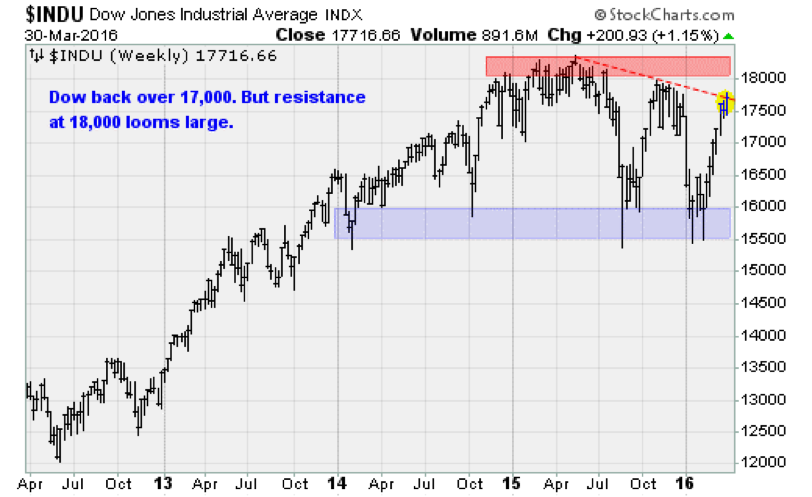Wall Street, for all its complexities, has been reduced to drooling, Pavlovian puppy dogs when Federal Reserve Chair Janet Yellen takes the microphone, as she did earlier this week.
The Dow Jones Industrial Average surged up and out of a three-week consolidation range after Yellen on Tuesday talked up the downside risks to the economy, talked down the recent rise in core inflation measures and generally, if subtly, pooh-poohed the chances of an April interest rate hike at a speech to the Economic Club of New York.
Coming on the heels of some hawkish commentary from other Fed officials in recent days, this was exactly what investors still addicted to the Fed's monetary largesse wanted to hear. Beneath the surface, though, there is building evidence that buyers are starting to balk after a powerful seven-week rally.
Related: The Brutal Economic Truth Behind the Rise of Trump
Stocks are on a knife's edge, poised to either break above a two-year downtrend pattern or fall back to support levels near the January-February lows. So the stakes are extremely high.
Yellen said that caution in the pace of rate hikes was "especially warranted" given the Fed's more limited ability to respond to a new recession with interest rates already so low and extraordinary measures such as negative interest rates having mixed success in Japan and the Eurozone.
She also highlighted concerns about slower global growth, tighter financial market conditions from the volatility seen earlier in the year and uncertainty surrounding China's currency valuation — with each mention of a stress point like manna from heaven for the liquidity-addicted bulls.

While the market’s gains in response to the speech were flashy, the overall situation remains vulnerable. Stocks and oil prices are overextended on a number of technical measures. U.S. economic growth expectations, as shown above, have been cratering. Corporate earnings remain weak with the first-quarter reporting season set to start in less than two weeks.
For the Fed, which claims data dependence based on the economy, not the stock market, its credibility will be tested by ongoing evidence of job market tightening and an acceleration in core measures of inflation. If these trends continue, Yellen will be hard pressed to come up with excuses, despite stock market volatility, to hold off on further rate hikes.
Related: Why Interest Rates Could Be Locked in Until 2018
We will get a fresh data point on Friday when the March jobs report is released. Analysts are looking for payroll growth of 210,000 with the unemployment rate holding steady at 4.9 percent. Any deviation from these estimates will either raise or lower rate-hike expectations. The strength of the job market will go a long way toward determining whether the next stop is Dow 18,000 (not seen since last summer) or Dow 16,000 (revisiting the January-February low).
Also keep in mind: As the calendar flips to April the old "Sell in May and go away" seasonal weakness meme will resurface.

On a technical basis, Wednesday was significant for the large number of "shooting star" patterns signifying buying exhaustion. You could see it on the Dow. You could see it with stocks like Apple (AAPL) and Microsoft (MSFT). And you could see it in the 58-plus percent drop in NYSE net advancing issues — to 770 — from Tuesday's advance.
Related: Here’s a Sign the Housing Market Is Returning to Normal
Another way to view this is by looking at the ratio of up volume vs. total volume on the NYSE. That also dropped Wednesday, by 9.2 percent, to 65 percent of total volume. Compare this to a high of 72 percent hit earlier in the week, and of 85 percent hit in early March, 90 percent hit in February and 92 percent hit in late January.
Buyers are simply finding fewer and fewer stocks compelling at these prices. Many see past Yellen's comments to a future where interest rates are forced higher by a healthy unemployment rate, stronger inflation and ongoing pressure on corporate earnings.
Anthony Mirhaydari is founder of the Edge and Edge Pro investment advisory newsletters. A two-week and four-week free trial offer has been extended to Fiscal Times readers.






